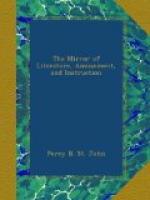The celebrity attendant on a royal visit adhered long to places as well as persons. A chamber in the decayed tower of Hoghton, in Lancashire, still bears the name of James the First’s room. Elizabeth’s apartment, and that of her maids of honour, are still known at Weston House, in Warwickshire; her walk “marked by old thorn-bushes,” at Hengrave, in Norfolk; near Harefield, the farm-house where she was welcomed by allegorical personages; at Bisham Abbey, the well in which she bathed; and at Beddington, in Surrey, her favourite oak. She often shot with a cross-bow in the paddock at Oatlands. At Hawsted, in Suffolk, she is reported to have dropped a silver-handled fan into the moat; and an old approach to Kenninghall Place, in Norfolk, is called Queen Bess’s Lane, because she was scratched by the brambles in riding through it.—Quarterly Review.
* * * * *
SHAKSPEARE’S MACBETH.
During one of the progresses of James I. on passing the gate of St. John’s College, at Oxford, his majesty was saluted by three youths, representing the weird sisters (sibyllae,) who, in Latin hexameters, bade the descendant of Banquo hail, as king of Scotland, king of England, and king of Ireland; and his queen as daughter, sister, wife, and mother of kings. The occasion is memorable in dramatic history, if it be true that this address, or a translation of it, led Shakspeare to write on the story of Macbeth. Much has been said for the probability of this supposition; but surely the legend of Macbeth and Banquo must have been abundantly discoursed of in England between James’s accession and the year when this pageant was exhibited; and Shakspeare could find every circumstance alluded to by the Oxford speakers, and many more in Holinshed’s Chronicle, which, through a great part of Macbeth, he has undoubtedly taken for his guide.—Ibid.
* * * * *
CHINESE DRAMA.
The Chinese themselves make no technical distinctions between tragedy and comedy in their stage pieces;—the dialogue of which is composed in ordinary prose, while the principal performer now and then chants forth, in unison with music, a species of song or vaudeville, and the name of the tune or air is always inserted at the top of the passage to be sung.— Quarterly Review.
* * * * *
THE HAWTHORN.
The trunk of an old hawthorn is more gnarled and rough than, perhaps, that of any other tree; and this, with its hoary appearance, and its fragrance, renders it a favourite tree with pastoral and rustic poets, and with those to whom they address their songs. Milton, in his L’Allegro, has not forgotten this favourite of the village:—
“Every shepherd tells his tale
Under the hawthorn in the dale.”




